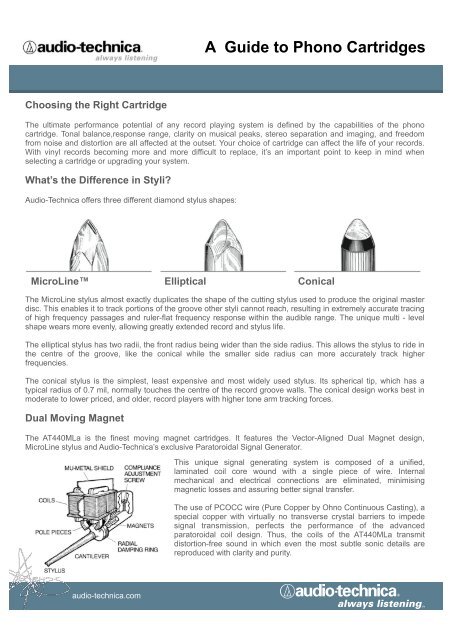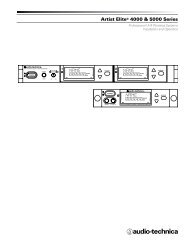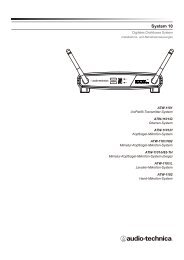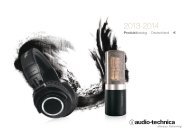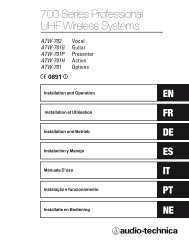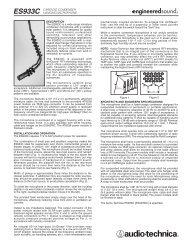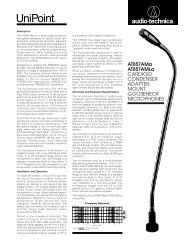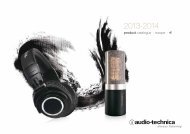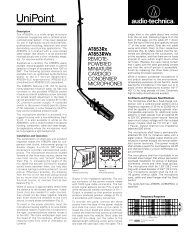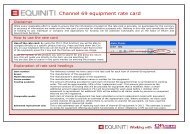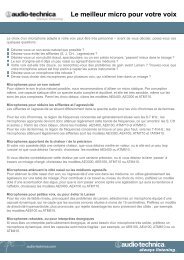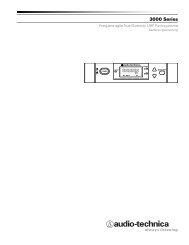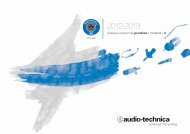A Guide to Phono Cartridges - Audio-Technica
A Guide to Phono Cartridges - Audio-Technica
A Guide to Phono Cartridges - Audio-Technica
You also want an ePaper? Increase the reach of your titles
YUMPU automatically turns print PDFs into web optimized ePapers that Google loves.
A <strong>Guide</strong> <strong>to</strong> <strong>Phono</strong> <strong>Cartridges</strong>Choosing the Right CartridgeThe ultimate performance potential of any record playing system is defined by the capabilities of the phonocartridge. Tonal balance,response range, clarity on musical peaks, stereo separation and imaging, and freedomfrom noise and dis<strong>to</strong>rtion are all affected at the outset. Your choice of cartridge can affect the life of your records.With vinyl records becoming more and more difficult <strong>to</strong> replace, it’s an important point <strong>to</strong> keep in mind whenselecting a cartridge or upgrading your system.What’s the Difference in Styli?<strong>Audio</strong>-<strong>Technica</strong> offers three different diamond stylus shapes:MicroLine Elliptical ConicalThe MicroLine stylus almost exactly duplicates the shape of the cutting stylus used <strong>to</strong> produce the original masterdisc. This enables it <strong>to</strong> track portions of the groove other styli cannot reach, resulting in extremely accurate tracingof high frequency passages and ruler-flat frequency response within the audible range. The unique multi - levelshape wears more evenly, allowing greatly extended record and stylus life.The elliptical stylus has two radii, the front radius being wider than the side radius. This allows the stylus <strong>to</strong> ride inthe centre of the groove, like the conical while the smaller side radius can more accurately track higherfrequencies.The conical stylus is the simplest, least expensive and most widely used stylus. Its spherical tip, which has atypical radius of 0.7 mil, normally <strong>to</strong>uches the centre of the record groove walls. The conical design works best inmoderate <strong>to</strong> lower priced, and older, record players with higher <strong>to</strong>ne arm tracking forces.Dual Moving MagnetThe AT440MLa is the finest moving magnet cartridges. It features the Vec<strong>to</strong>r-Aligned Dual Magnet design,MicroLine stylus and <strong>Audio</strong>-<strong>Technica</strong>’s exclusive Para<strong>to</strong>roidal Signal Genera<strong>to</strong>r.This unique signal generating system is composed of a unified,laminated coil core wound with a single piece of wire. Internalmechanical and electrical connections are eliminated, minimisingmagnetic losses and assuring better signal transfer.The use of PCOCC wire (Pure Copper by Ohno Continuous Casting), aspecial copper with virtually no transverse crystal barriers <strong>to</strong> impedesignal transmission, perfects the performance of the advancedpara<strong>to</strong>roidal coil design. Thus, the coils of the AT440MLa transmitdis<strong>to</strong>rtion-free sound in which even the most subtle sonic details arereproduced with clarity and purity.audio-technica.com
A <strong>Guide</strong> <strong>to</strong> <strong>Phono</strong> <strong>Cartridges</strong>Dual Moving MicroCoilThe OC9MLII possesses the basic A-T Vec<strong>to</strong>r-Aligned design, but utilises two tiny moving coils mounted at 90degrees in place of the two moving magnets.Many serious audiophiles prefer moving coil designs, citing clarityand transparency of <strong>to</strong>ne, better defined transients, precise stereoimaging and lower dis<strong>to</strong>rtion as the reasons for their preference.(Please note that moving coil cartridges require receivers orpreamps with special compatible inputs. Also, their stylusassemblies are not field-replaceable.)The OC9MLII features a MicroLine stylus, PCOCC coil windings forlow-loss signal transmission, a high-flux samarium cobalt magnetand a low-resonance, gold-plated boron cantilever.A Word About Mounts<strong>Audio</strong>-<strong>Technica</strong> cartridges are designed with one of three mount- ing options: the P-mount (plug-in), the half-inch(1⁄2") mount, or the universal mountHalf-Inch mountP-mountUniversal mountA P-mount cartridge has four terminals at the back that simply plug in <strong>to</strong> the end of the <strong>to</strong>ne arm. The cartridge isthen secured <strong>to</strong> the <strong>to</strong>ne arm with a single screw.A half-inch mount cartridge also has four terminals at the back, but they are larger pins that connect <strong>to</strong> fourindividual wires at the end of the <strong>to</strong>ne arm. The cartridge is secured <strong>to</strong> the <strong>to</strong>ne arm’s headshell with two screws,spaced 1⁄2" apart.An A-T universal mount model is a P-mount cartridge with an included half-inch adapter bracket. It is thuscompatible with both P-mount and half-inch mount <strong>to</strong>ne arms.audio-technica.com


